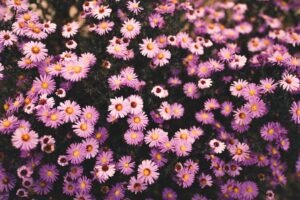The world of flowers is a truly enchanting one, filled with an array of colors and scents that captivate our senses. Among the many colors that flowers come in, purple is often considered one of the most mesmerizing and captivating. Purple blossoming flowers have a unique allure that sets them apart from other colors, and they have been cherished and admired throughout history. In this article, we will delve into the enchanting world of purple blossoming flowers, exploring their beauty, symbolism, scientific aspects, and various uses in different cultures and aspects of life.
Key Takeaways
- Purple flowers have a unique charm that enchants people all over the world.
- Different cultures attach different symbolic meanings to purple flowers, such as royalty, spirituality, and creativity.
- The vibrant hues of purple blooms are due to the presence of pigments called anthocyanins, which also have antioxidant properties.
- There are many varieties of purple flowers, each with its own characteristics and growing requirements.
- To grow and care for purple blossoming flowers, you need to provide them with the right soil, water, and sunlight, and protect them from pests and diseases.
Discovering the Enchanting World of Purple Blossoming Flowers
Purple flowers come in a variety of shades and hues, ranging from soft lavender to deep violet. Some popular examples of purple flowers include lavender, lilac, and iris. Lavender is known for its delicate purple blooms and its soothing fragrance. It is often used in aromatherapy and herbal remedies due to its calming properties. Lilacs, on the other hand, are known for their vibrant purple clusters of flowers that bloom in the spring. They are often associated with romance and are a popular choice for weddings and special occasions. Iris flowers are known for their unique shape and stunning purple petals. They symbolize faith, wisdom, and hope.
The allure of purple flowers extends beyond their individual beauty. When incorporated into gardens or floral arrangements, they add a touch of elegance and sophistication. Purple flowers can create a sense of tranquility and serenity in a garden, making it a peaceful retreat. In floral arrangements, they can be used to create striking contrasts or to add depth and richness to a bouquet. Whether used alone or combined with other colors, purple flowers have the ability to captivate and enchant.
The Symbolic Meaning of Purple Flowers in Different Cultures
Purple flowers have held symbolic meanings in various cultures throughout history. In ancient Greek and Roman mythology, purple flowers were associated with gods and goddesses. For example, the iris flower was named after the Greek goddess Iris, who was believed to use the rainbow as a bridge between heaven and earth. The color purple was also associated with royalty and power in these ancient civilizations.
In Eastern cultures, purple flowers are often associated with spirituality and enlightenment. In Buddhism, the lotus flower is highly revered and symbolizes purity and spiritual awakening. The lotus flower can be found in various shades of purple, and its beauty is often used as a metaphor for the journey towards enlightenment.
In Christian symbolism, purple flowers are often associated with Lent and Easter. During Lent, purple is used to represent penance and preparation for the resurrection of Jesus Christ. Purple flowers are often used in church decorations during this time to symbolize this period of reflection and renewal.
The Science Behind the Vibrant Hues of Purple Blooms
| Plant Species | Pigment | Chemical Formula | Color |
|---|---|---|---|
| Lavender | Anthocyanin | C15H11O6N | Purple |
| Iris | Anthocyanin | C15H11O6N | Purple |
| Lilac | Flavonol | C15H10O7 | Pale Purple |
| Hydrangea | Anthocyanin | C15H11O6N | Blue or Pink (depending on soil acidity) |
The vibrant hues of purple blooms are created by pigments called anthocyanins. Anthocyanins are water-soluble pigments that belong to a larger group of compounds called flavonoids. These pigments are responsible for the red, blue, and purple colors found in many fruits, vegetables, and flowers.
The intensity of the purple color in flowers can be influenced by various factors. One factor is pH levels in the plant’s cells. Anthocyanins can change color depending on the acidity or alkalinity of their environment. For example, in more acidic conditions, anthocyanins may appear red or pink, while in more alkaline conditions, they may appear blue or purple.
Other factors that can affect the intensity of purple hues in flowers include sunlight exposure, temperature, and genetics. Sunlight exposure can enhance the production of anthocyanins in plants, leading to more vibrant colors. Temperature can also affect the production of anthocyanins, with cooler temperatures often resulting in deeper purple hues. Additionally, different plant species and cultivars may have varying levels of anthocyanins, leading to differences in color intensity.
Exploring the Different Varieties of Purple Flowers and Their Unique Characteristics
There are numerous varieties of purple flowers, each with its own unique characteristics. Some examples include the purple coneflower, which is known for its daisy-like petals and its ability to attract butterflies and bees. The purple coneflower is also used in herbal remedies for its immune-boosting properties.
Another example is the purple petunia, which is a popular choice for hanging baskets and containers due to its trailing habit and vibrant purple blooms. The scent of lavender is also a unique characteristic of certain purple flowers. Lavender flowers are known for their calming fragrance, which is often used in aromatherapy to promote relaxation and sleep.
How to Grow and Care for Purple Blossoming Flowers in Your Garden

If you want to incorporate purple blossoming flowers into your garden, there are a few tips to keep in mind. First, it’s important to choose the right location for your plants. Most purple flowers thrive in full sun or partial shade, so make sure to provide them with the appropriate amount of sunlight. Additionally, well-draining soil is essential for the health and growth of your plants.
When it comes to watering, it’s important to strike a balance. Overwatering can lead to root rot, while underwatering can cause the plants to wilt and die. It’s best to water your plants deeply but infrequently, allowing the soil to dry out slightly between waterings.
Fertilizing your plants can also help promote healthy growth and vibrant blooms. Use a balanced fertilizer that is specifically formulated for flowering plants, following the instructions on the package for application rates.
The Role of Purple Flowers in Attracting Pollinators and Beneficial Insects
Purple flowers play a crucial role in attracting pollinators and beneficial insects to your garden. Bees, butterflies, and hummingbirds are particularly attracted to purple flowers due to their vibrant colors and sweet nectar. These pollinators play a vital role in the reproduction of plants, as they transfer pollen from one flower to another, allowing for fertilization and the production of seeds.
In addition to pollinators, purple flowers also attract beneficial insects such as ladybugs and lacewings. These insects feed on pests such as aphids and mites, helping to keep your garden free from harmful insects without the need for chemical pesticides.
The Healing Properties of Purple Flowers in Traditional Medicine
Purple flowers have long been used in traditional medicine for their healing properties. Lavender, for example, is known for its calming and soothing effects. It is often used in aromatherapy to promote relaxation and relieve stress. Lavender oil can also be applied topically to soothe minor skin irritations and promote healing.
Another example is the purple coneflower, also known as echinacea. This flower has been used for centuries by Native Americans for its immune-boosting properties. It is often used in herbal remedies to help prevent and treat colds, flu, and other respiratory infections.
Purple Flowers as a Source of Inspiration for Art and Literature
Purple flowers have long been a source of inspiration for artists and writers. In art, purple flowers have been depicted in various forms, from delicate watercolor paintings to bold abstract compositions. Famous works of art featuring purple flowers include Vincent van Gogh’s “Irises” and Claude Monet’s “Water Lilies.”
In literature, purple flowers are often used as symbols of beauty, mystery, and spirituality. They can represent love, passion, or even death. Examples of famous literary works featuring purple flowers include William Shakespeare’s “Hamlet,” where Ophelia gives a speech about the symbolic meaning of flowers, and Emily Dickinson’s poem “I’m Nobody! Who are you?” which includes the line “How dreary to be somebody! How public, like a frog, to tell your name the livelong June, to an admiring bog!”
The Significance of Purple Flowers in Weddings and Special Occasions
Purple flowers are often chosen for weddings and special occasions due to their symbolic meanings and their ability to create a sense of elegance and sophistication. In weddings, purple flowers are often used in bouquets, centerpieces, and decorations. They can add a pop of color to a white wedding dress or complement a purple-themed wedding.
The symbolism of purple flowers in different types of special occasions can vary. For example, in birthdays or anniversaries, purple flowers can represent royalty and admiration. In funerals or memorial services, purple flowers can symbolize mourning and remembrance.
Preserving the Beauty of Purple Blossoming Flowers: Tips for Drying and Pressing
If you want to preserve the beauty of purple blossoming flowers, drying and pressing them is a great option. To dry flowers, you can hang them upside down in a cool, dark place with good air circulation. This method allows the flowers to dry naturally while maintaining their shape and color.
To press flowers, you can place them between layers of absorbent paper or in a flower press. Apply pressure evenly to flatten the flowers, and leave them pressed for several weeks until they are completely dry. Pressed flowers can be used in various crafts and projects, such as making greeting cards or creating framed artwork.
Purple blossoming flowers have an enchanting beauty that has captivated humans for centuries. From their vibrant hues to their symbolic meanings, purple flowers hold a special place in our hearts and cultures. Whether used in gardens, floral arrangements, or various aspects of life, purple flowers add a touch of elegance and sophistication. Their healing properties, role in attracting pollinators, and inspiration in art and literature further enhance their significance. So next time you come across a purple blossoming flower, take a moment to appreciate its beauty and the rich history and symbolism it holds.
If you’re a fan of purple flowers, you’ll love this article on the mesmerizing beauty of lavender fields. Discover how these vibrant purple blooms can instantly uplift your mood and add a touch of elegance to any garden. Learn about the different varieties of lavender and how to care for them to ensure they thrive in your own backyard. For more inspiration and tips on creating a stunning floral display, check out this article: Lavender Fields: A Purple Paradise for Flower Enthusiasts.




















+ There are no comments
Add yours